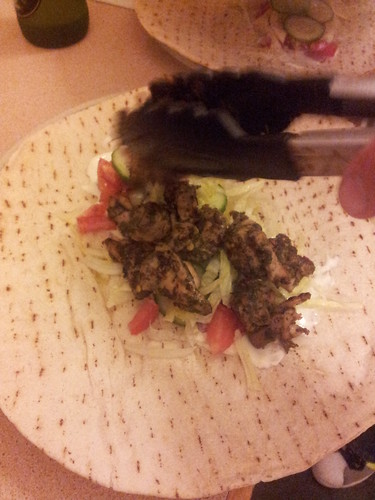Action shot! Another awful photo but I have just acquired a new phone … will you be able to tell the difference?!
I’m not sure whether I should be putting a disclaimer on this piece or not … I received this product in a goody bag at a totally unrelated event (albeit one that celebrated South Australian produce). So while I didn’t pay for it, I have no relationship with either the producer or its marketing/PR people.
Anyway, wraps in one form or another are always a great hit for an easy dinner here. You do have to make sure you buy a decent wrap: the wrong form of carbohydrate can either ruin the flavour of your dinner or leave it all over your lap. But once you have sorted the bread part, you just need to cook a little meat, chop a little salad and find a dollop of yoghurt and you are good to go.
Of course, you do need to get flavour into the meat (or filling). Making felafel – especially if you decide to crack out the deep fat fryer – can be time consuming and even whipping up a Mexican inspired filling can take a little while.
I am not normally a fan of pre-prepared spice mixes because you are, by and large, paying for salt, salt, a bit more salt and then a few other bits and pieces. I’m fortunate to have a well stocked spice drawer and the inclination to mix-my-own which is not only more satisfying but also more cost effective.
However, Outback Pride’s Tanami Fire is a spice mix that I am not inclined to make myself and that both Andy and I have decided we would definitely part with our hard earned for.
For those not in the know, the Tanami Desert is 26 million hectares of desert in Australia’s Northern Territory and it is home to several endangered species.
Tanami Fire is described as a ‘hot spice sprinkle’ which is made from a variety of native Australian plants I can almost guarantee you won’t have kicking around your spice cupboard. The list of ingredients reads: ground Tanami apples, native pepperberry, lemon aspen, garlic, ginger, chilli flakes, salt and saltbush flakes. The label notes that the native Australian ingredients have been grown in a bio-dynamic environment. Outback Pride is a South Australian company that involves the state’s traditional communities in production and provides not only jobs but training in associated industries such as horticulture.
So it’s an all round feel good story.
Of course, that matters not a jot if the end product is not tasty. But tasty it is. We’ve used it several times now in different capacities, but by far the easiest has been to create a quick and tasty filling for a wrap.
No proper recipe today – simply dice or slice your meat (in our case, chicken) and sprinkle generously with the spice mix. A marinade for half an hour or so, if you can afford it, and then fry up. Serve in the wrap on top of salad and with some yoghurt. If you really want to do a bit more chopping, mix some finely minced garlic through that yoghurt!
The Tanami Fire mix has a citrussy spicy flavour – it is quite hot so if you’re a bit averse to chilli go easy. We’ve been thrashing it a bit and come BBQ time it will be perfect as a marinade or to use after the fact to jazz up some meat.



